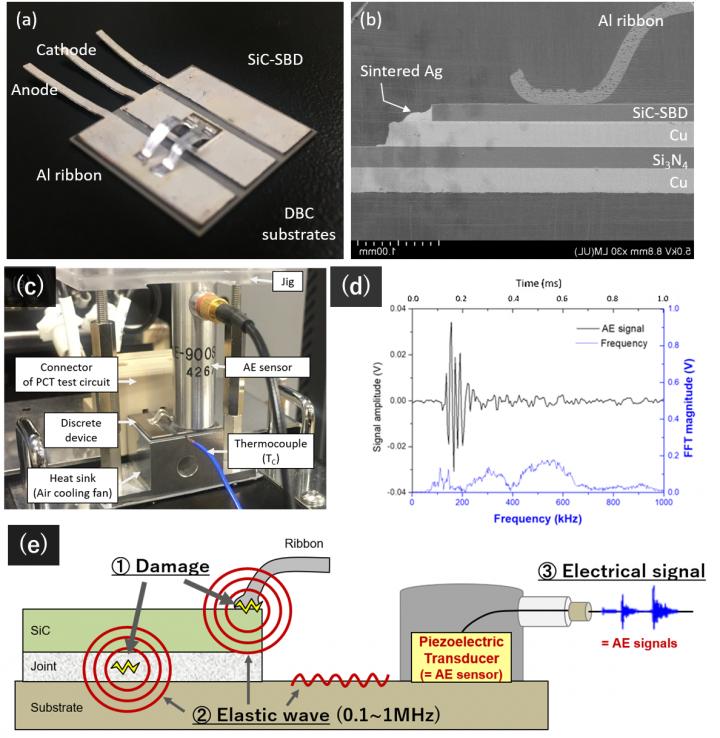Detecting early-stage failure in electric power conversion devices

Acoustic emission (AE) was applied to monitor wear-out failure in discrete SiC Schottky barrier diode (SBD) devices with a Ag sinter die attachment, to successfully monitor the real-time progress of failure of Al ribbons for the first time. (a) Optical image of a SiC-SBD device. (b) Cross-sectional SEM image. (c) Experimental apparatus for power cycling tests and real-time AE monitoring. (d) Waveform of collected AE signal and its characteristic, including counts and amplitude. (e) Generation, propagation, and collection of AE signals (i.e., elastic waves) in power electronics during a power cycling test.
Credit: Osaka University
Researchers from Osaka University use non-destructive acoustic monitoring to identify the earliest stages of failure in silicon carbide power electronics, which will help in the design of more-durable power devices.
Power electronics regulate and modify electric power. They are in computers, power steering systems, solar cells, and many other technologies. Researchers are seeking to enhance power electronics by using silicon carbide semiconductors. However, wear-out failures such as cracks remain problematic. To help researchers improve future device designs, early damage detection in power electronics before complete failure is required.
In a study recently published in IEEE Transactions on Power Electronics, researchers from Osaka University monitored in real time the propagation of cracks in a silicon carbide Schottsky diode during power cycling tests. The researchers used an analysis technique, known as acoustic emission, which has not been previously reported for this purpose.
During the power cycling test, the researchers mimicked repeatedly turning the device on and off, to monitor the resulting damage to the diode over time. Increasing acoustic emission corresponds to progressive damage to aluminum ribbons affixed to the silicon carbide Schottsky diode. The researchers correlated the monitored acoustic emission signals to specific stages of device damage that eventually led to failure.
“A transducer converts acoustic emission signals during power cycling tests to an electrical output that can be measured,” explains lead author ChanYang Choe. “We observed burst-type waveforms, which are consistent with fatigue cracking in the device.”
The traditional method of checking whether a power device is damaged is to monitor anomalous increases in the forward voltage during power cycling tests. Using the traditional method, the researchers found that there was an abrupt increase in the forward voltage, but only when the device was near complete failure. In contrast, acoustic emission counts were much more sensitive. Instead of an all-or-none response, there were clear trends in the acoustic emission counts during power cycling tests.
“Unlike forward voltage plots, acoustic emission plots indicate all three stages of crack development,” says senior author Chuantong Chen. “We detected crack initiation, crack propagation, and device failure, and confirmed our interpretations by microscopic imaging.”
To date, there has been no sensitive early-warning method for detecting fatigue cracks that lead to complete failure in silicon carbide Schottsky diodes. Acoustic emission monitoring, as reported here, is such a method. In the future, this development will help researchers determine why silicon carbide devices fail, and improve future designs in common and advanced technologies.
###
The article, “Real-time acoustic emission monitoring of wear-out failure in SiC power electronic devices during power cycling tests,” was published in IEEE Transactions on Power Electronics at DOI: https:/
About Osaka University
Osaka University was founded in 1931 as one of the seven imperial universities of Japan and is now one of Japan’s leading comprehensive universities with a broad disciplinary spectrum. This strength is coupled with a singular drive for innovation that extends throughout the scientific process, from fundamental research to the creation of applied technology with positive economic impacts. Its commitment to innovation has been recognized in Japan and around the world, being named Japan’s most innovative university in 2015 (Reuters 2015 Top 100) and one of the most innovative institutions in the world in 2017 (Innovative Universities and the Nature Index Innovation 2017). Now, Osaka University is leveraging its role as a Designated National University Corporation selected by the Ministry of Education, Culture, Sports, Science and Technology to contribute to innovation for human welfare, sustainable development of society, and social transformation. Website: https:/
All latest news from the category: Power and Electrical Engineering
This topic covers issues related to energy generation, conversion, transportation and consumption and how the industry is addressing the challenge of energy efficiency in general.
innovations-report provides in-depth and informative reports and articles on subjects ranging from wind energy, fuel cell technology, solar energy, geothermal energy, petroleum, gas, nuclear engineering, alternative energy and energy efficiency to fusion, hydrogen and superconductor technologies.
Newest articles

You are What You Eat—Stanford Study Links Fiber to Anti-Cancer Gene Modulation
The Fiber Gap: A Growing Concern in American Diets Fiber is well known to be an important part of a healthy diet, yet less than 10% of Americans eat the minimum recommended…

Trust Your Gut—RNA-Protein Discovery for Better Immunity
HIRI researchers uncover control mechanisms of polysaccharide utilization in Bacteroides thetaiotaomicron. Researchers at the Helmholtz Institute for RNA-based Infection Research (HIRI) and the Julius-Maximilians-Universität (JMU) in Würzburg have identified a…

ASXL1 Mutation: The Hidden Trigger Behind Blood Cancers and Inflammation
Scientists show how a mutated gene harms red and white blood cells. LA JOLLA, CA—Scientists at La Jolla Institute for Immunology (LJI) have discovered how a mutated gene kicks off…



